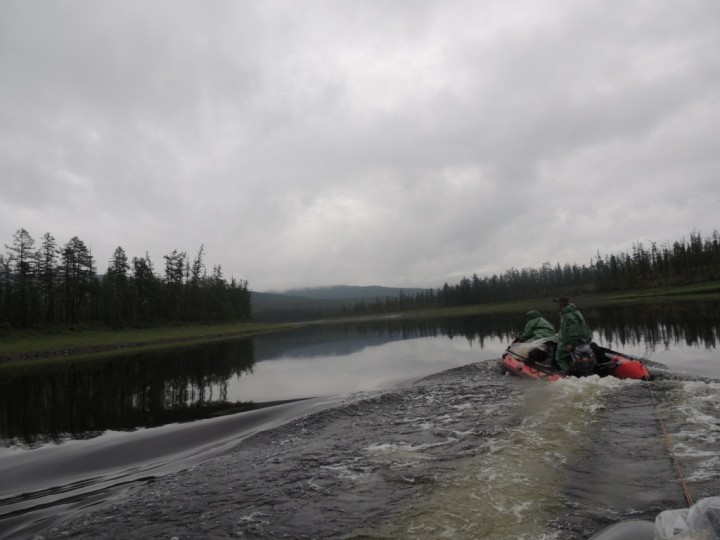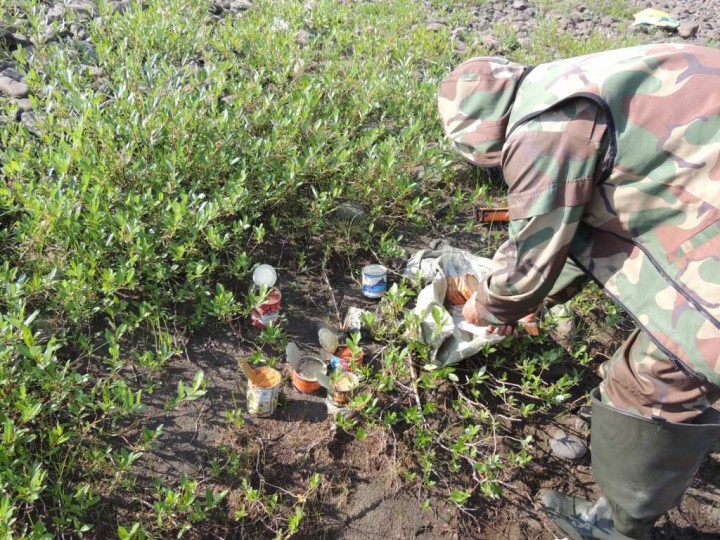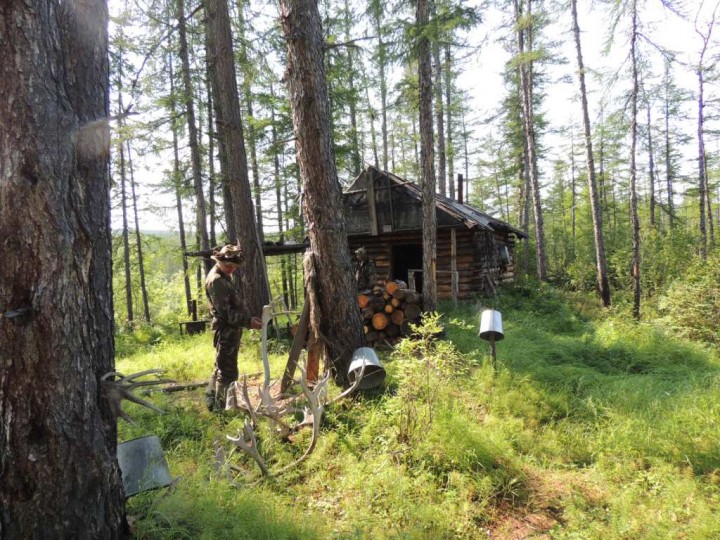Embenchime River
9:30 p.m. Siberia, 9:30 a.m. EDT
65°F High 54°F low Rain
Dr. Ranson reports:
We’re at the end of another long journey on the Embenchime. We’ve covered 38 kilometers in a straight line – with the twists and turns, of the river, multiply that by about 1 ½ – so it’s more like 57 km. We left here about 10:20 this morning, and arrived at our camp about 8 p.m. That’s a long day. A little over 9 ½ hour to get that far.
It rained all night long, a very persistent pattering down. We planned to wake up at 7 a.m., bright and early. For some reason I was stirring about 6:30, and listened to the rain, disappointed that it would be another soggy day. But, at about 6:45, right before everyone was due to get up – the rain stopped! What a coincidence! We welcomed the rain, because this region needs water. But we’re also quite pleased to be dry.

The river was higher and kinder today, allowing the scientists a little rest and time to think. Here the red boat takes the lead and powers the group down the river. There were still many shallows, especially in the river bends, and the boats again sustained some damage.
Not that it stayed dry all day. Just as the river has been working us hard, the weather teased us today. We had a nice start to the day, but then, around noon, it started raining again. Again, a steady rain – no storms, no drama, just soaking and relentless rain. Then it quit about 5 or 6. The peeked came out and the clouds began to drift off. We began to hope for steadily better weather.
Around 8 p.m., we saw a decent campsite – a rocky shore – and since we like to sleep on rocks (actually, that’s our only choice here!), we pulled over and began to set up camp. The sky was blue, and a nice little breeze had popped up. My tent and sleeping bag had gotten a little wet last night, so I laid them out on the rocks to dry, and so did the others. We were pleased – we were going to have a dry night!
Just as we were feeling pretty satisfied, this little rain cloud came up, very fast – right over our stuff! It poured down – and we just stood there – staring. What else could we do? It was a little cloud, very localized, and the rain only lasted five minutes. Just long enough to get us nice and wet for the evening. I guess we get reminders of exactly who is control here – and it is not us.
Now it’s cloudy, but no rain. It’s very peaceful, and the ever present mosquitoes seem to be rather calm, as well.
Our Russian colleagues are cooking dinner. It smells very good. Our diet has changed from fish to spaghetti. We’ve had it three meals in a row now. Noodles and tomato sauce, with canned beef most of the time. We haven’t had much time to fish, so we’re back to the canned things. Every lunch, we’ve each had our little Snickers bar. Pasha always brings them along for us, and makes sure we get our candy bar every lunch time. I had to admit, I’ve developed a little bit of addiction. It’s a treat, it’s sweet, and I look forward to it. They are real Snickers bars – but they aren’t American. They have Russian writing on them. I don’t eat candy much at home, but I think these taste just like our American version.
Well, today, we had a little bit of a tragedy. At lunch time, we laid out all of our food, and I looked around – and there were no Snickers bars at all. Pasha has a trained – we stop, we lay out the food, and he gives us a candy bar. We’re not quite Pavlov’s dogs, but we’ve become, quite unwittingly, something like them – you could call us Pasha’s scientists, I guess. The food was all there – but no candy. Then Pasha shook his head – no more Snickers.
Oh – that was hard! I was disappointed – unreasonably disappointed. I know the expedition is hard, and I just deal with it all. The wet, the hot, the bugs, the paddling, the blisters, the sore muscles, the rocks we get to sleep on – no real problem. But – no Snickers? That’s tough! Guoqing saved the day, today – he had a few Hershey’s bars to hand out. They had English writing on them, and he’d brought them from home. However, I have a suspicion that we have now eaten all our treats. That’s really rather sad.

Here Pasha lays out a typical lunch – a smorgasbord of canned delights. Along with the canned food, lunchtime usually ends with a daily treat – a Snickers bar. Today, the stock of Snickers has seemed to run out, much to the disappointment of the scientific team.
This whole trip, we have seen no active forest fires burning. But it’s easy to see that this area has burned many times over the last many years. Almost everywhere we see signs of past fires. An area near hear is relatively freshly burned – about 10 years ago. That seems like the most recent fire scar we’ve seen.
That said, the floors of these forests are full of moss, and lichen and lots of dry things. If there was a big lightning strike, it could ignite quite easily. Or if people were careless with fire, of course. But there are not a lot of people up here. Most fires in remote northern Siberia, where people are few, are naturally ignited by lightning. It is thought that in more populated area, human activity is the driver that starts most fires.
The forests are quite stunning here. We’re not seeing dramatic rock formations, like we have on expeditions further north. What we have here are hills full of green trees, and lots of basaltic boulders. And the clear waters of the shallow Embenchime. Taken all together, it is quite a pretty place – if you like trees, that is.
The river is a little fuller today – the rain has helped. Still, there are a lot of shallows. We’re getting a rhythm down, and learning to work with the river and with each other a bit more efficiently. We jump out, lift and pull the boats over the river, and soon are on our way again. I think we are starting to make up some time. If we can get one more really good day on the river, we will be back on schedule.
Yesterday’s rain helped fill the river, plus we passed three or four small creeks, tributaries to the Embenchime, and that helped as well. We went through an area with six or seven tight bends – almost a corkscrew. At each bend, we have to get out, we wear waders so we’re always ready to jump in the river, if we have to, and we then we pull or carry the heavy boats, until we get into deeper water. The quick bends just wear us out.
The white boat had a big hole in it, today, again. We still are getting sideways on dragon’s teeth, and still scraping the bottoms on the rocks, and the boats get hurt. We haven’t lost any equipment, and we haven’t gotten anyone hurt. We’re all doing great. The boats, however, stay pretty unhappy. We’ll have to fix them tonight or tomorrow. Then we get back on the river for another day’s ride. We have places to go, and trees to see.

Even though this is a really remote part of the world, people are beginning to move into the forest, and have their direct impact on the land. The forests here, however, are connected in a very real way to the rest of the Earth, and to each individual, and to each human community. What we do in our lives and our communities affects these forests, and the ability of these forests to take in carbon affects our human communities. The bond is invisible, but it is real. We are all connected.
The river was kind today, so I had a little time to think. I was thinking about how much carbon these trees absorb. They have the power to absorb some of the addition carbon dioxide that people are putting into the atmosphere. They are cleansing what we are polluting, so to speak.
But the trees don’t know they are doing that – they have no way to understand how much carbon we’re putting into the atmosphere. The trees just are living here, and they just respond to conditions as they change. It’s an amazing system – that these trees can change how they live as conditions change, and they are one of Earth’s homeostatic mechanisms, one of the players in the feed-back loops that help maintain conditions on Earth, so that it stays suitable for life. Of course, the forests have their limitations to mitigate changes, but they play an important role in Earth’s stability as our home.
It’s really true that we are all connected – these trees and the people at my home. We all share the one Earth. And the trees in the boreal forest respond to what we do, and are mitigating what we do. It’s kind of amazing – who could imagine that the trees in these forests, so far away, are connected to my home, and your home? But it’s true, in a real sense. And the more we study, the more we discover just how connected all life really is.
Not too long ago, scientists tended to look only at their little field, and focus on their own questions, with minimal interactions with other Earth systems. But now, scientists are trying to think of the Earth as a full system – land, ocean, atmosphere. And we are, more and more, realizing that the interactions are very complex, very intricate – and very important.
It would be good if people would think of the Earth as a system. It would be good if people could feel connected to the entire Earth, not just their own home. In a real sense, there is an impact on what we do in our world – in our cities and our farms and our businesses – there is an impact on the rest of the world. It impacts the forests, and the ice sheets, and those changes, in turn, impact us. It’s really true – we are making choices of how we are going to live – and how we choose to live has a profound impact not just on each of us – but on our entire Earth.
I’ve also been thinking of the cycle of life. I’m here now, and I’ll go home soon. The birds are here – they will go south soon, like they do each year. The forests are growing here – but soon they will burn, then grow again. There is a cycle that repeats.
At the same time, things are changing. Forests burn more frequently. Migratory patterns seem to be changing. People come to these boreal forests more frequently, and people are pumping out carbon at an unprecedented rate.
As the climate warms, these forests may exploit their potential for growth, and expand. As the climate warms, the permafrost will begin to melt, the carbon-rich soils will decompose, and carbon and methane will begin to enter the atmosphere more and more. The forests, at first, will expand, and take in more carbon – but can they take in enough, enough to stabilize the system? There is potential for huge change – in our homes, and here as well. This ecosystem is pretty pristine, and we can see the changes as they begin. We are seeing signs of change, and have for the last several years. But the big change is not really rolling yet. It’s so important to study this area, to learn what impact it has in the balance of our Earth, and how we are impacting both these forests and Earth’s balance. I encourage everyone to begin to realize that, in fact – we really are connected.




I read all the blogs that Beth sends me- wish I were close enough to send all of you more snickers–they are my favorite also. Look forward to spending time with you Ross in the fall, Jean
Thank you for the wonderful notes from the field. I feel I was taking the journey with you there. We surely are connected. Best wishes for the remaining field trip.
What an incredible journey! Thank you for enduring the pains of the wilderness to help all of us understand & appreciate our Mother earth better so that we can all work together to preserve her beauty and her complex dynamics. No more chocolate? It’s time to return home!
Thank you for sharing your experiences. We are certainly connected on this “tiny blue dot.” What a beautiful, but fragile planet.